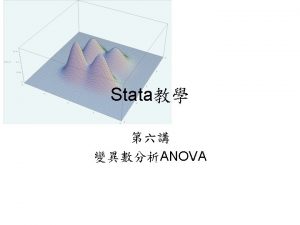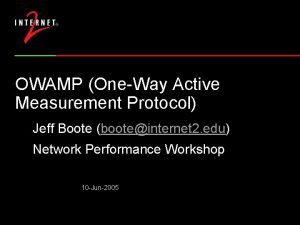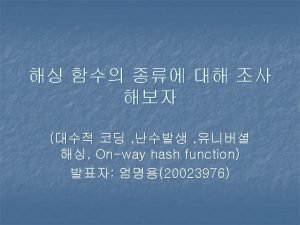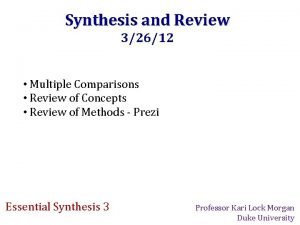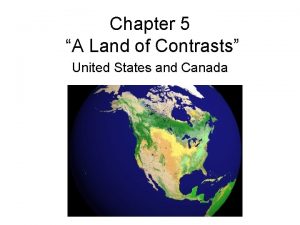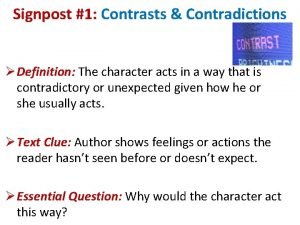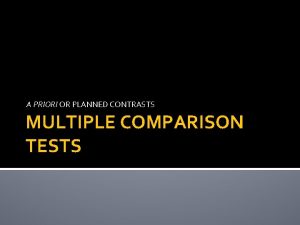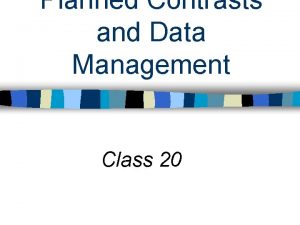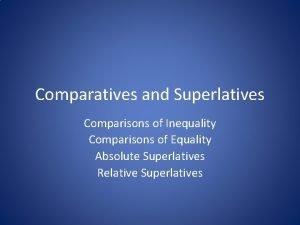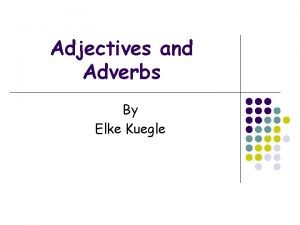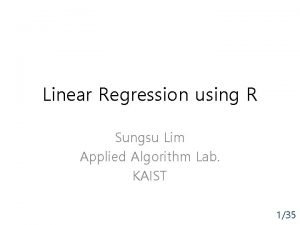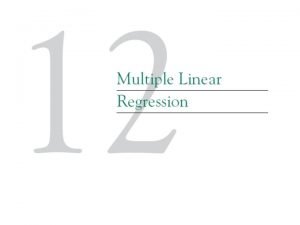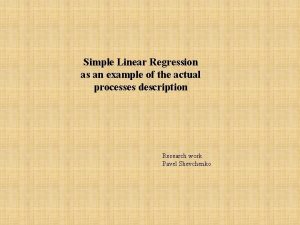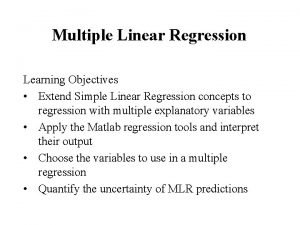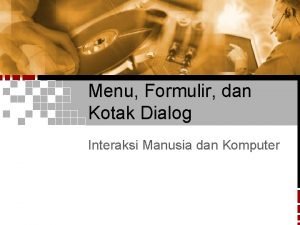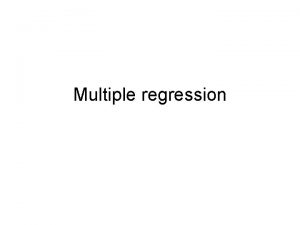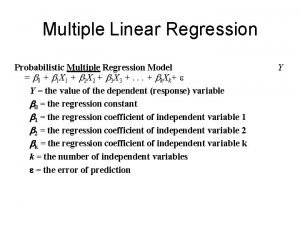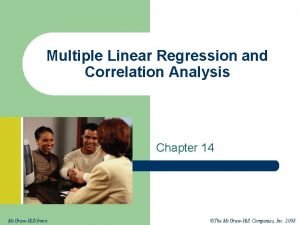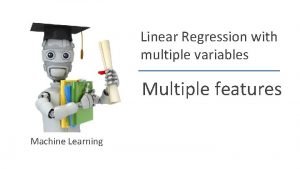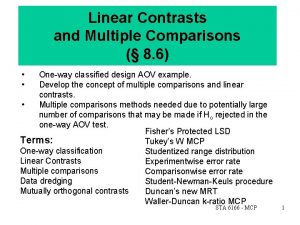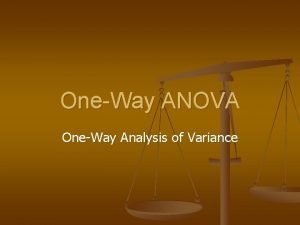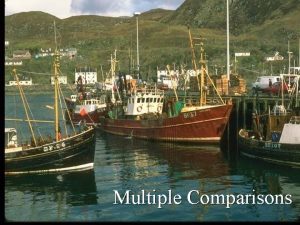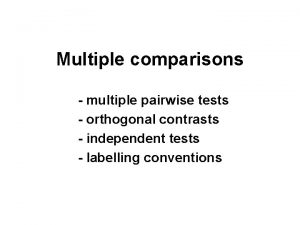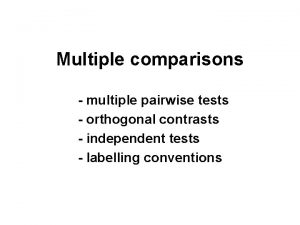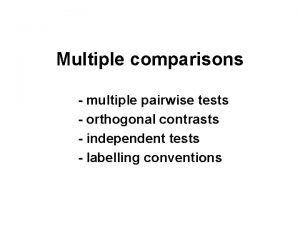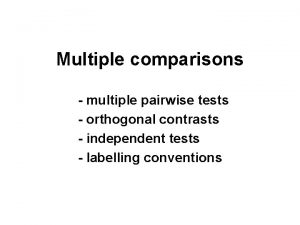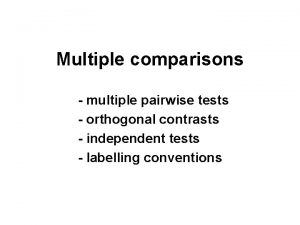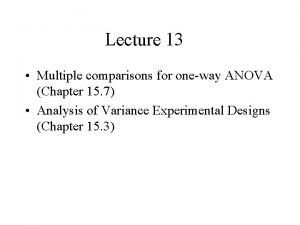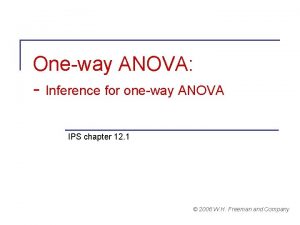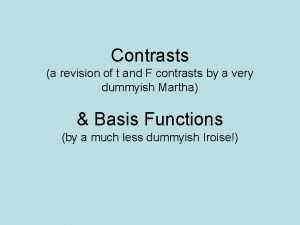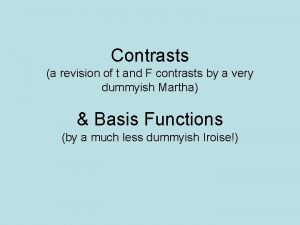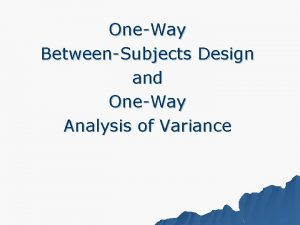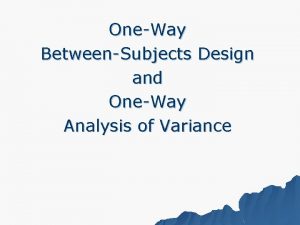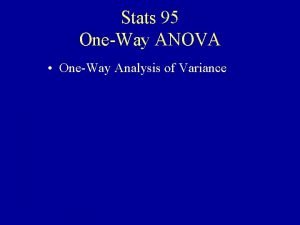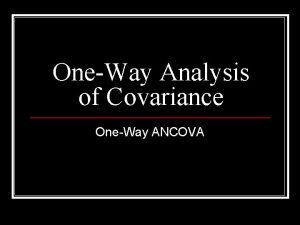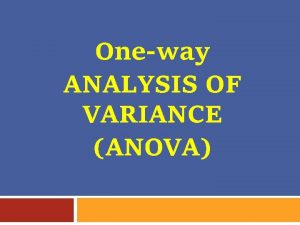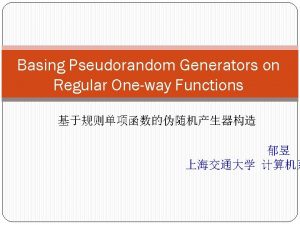Linear Contrasts and Multiple Comparisons Chapter 9 Oneway






































- Slides: 38

Linear Contrasts and Multiple Comparisons (Chapter 9) • • • One-way classified design AOV example. Develop the concept of multiple comparisons and linear contrasts. Multiple comparisons methods needed due to potentially large number of comparisons that may be made if Ho rejected in the one-way AOV test. Terms: Linear Contrasts Multiple comparisons Data dredging Mutually orthogonal contrasts Experimentwise error rate Comparisonwise error rate MCPs: Fisher’s Protected LSD Tukey’s W (HSD) Studentized range distribution Student-Newman-Keuls procedure Scheffe’s Method Dunnett’s procedure STA 6166 - MCP 1

One-Way Layout Example A study was performed to examine the effect of a new sleep inducing drug on a population of insomniacs. Three (3) treatments were used: Standard Drug New Drug Placebo (as a control) What is the role of the placebo in this study? What is a control in an experimental study? 18 individuals were drawn (at random) from a list of known insomniacs maintained by local physicians. Each individual was randomly assigned to one of three groups. Each group was assigned a treatment. Neither the patient nor the physician knew, until the end of the study, which treatment they were on (double-blinded). Why double-blind? A proper experiment should be: randomized, controlled, and double-blinded. STA 6166 - MCP 2

Response: Placebo: Standard Drug: New Drug: Average number of hours of sleep per night. 5. 6, 5. 7, 5. 1, 3. 8, 4. 6, 5. 1 8. 4, 8. 2, 8. 8, 7. 1, 7. 2, 8. 0 10. 6, 6. 6, 8. 0, 6. 8, 6. 6 yij = response for the j-th individual on the i-th treatment. Hartley’s test for equal variances: Fmax = 4. 77 < Fmax_critical = 10. 8 STA 6166 - MCP 3

Excell Analysis Tool Output What do we conclude here? STA 6166 - MCP 4

Linear Contrasts and Multiple Comparisons If we reject H 0 of no differences in treatment means in favor of HA, we conclude that at least one of the t population means differs from the other t-1. Which means differ from each other? Multiple comparison procedures have been developed to help determine which means are significantly different from each other. Many different approaches - not all produce the same result. Data dredging and data snooping - analyzing only those comparisons which look interesting after looking at the data – affects the error rate! Problems with the confidence assumed for the comparisons: 1 - for a particular pre-specified comparison? 1 - for all unplanned comparisons as a group? STA 6166 - MCP 5

Linear Comparisons Any linear comparison among t population means, m 1, m 2, . . , mt can be written as: Where the ai are constants satisfying the constraint: Example: To compare m 1 to m 2 we use the equation: with coefficients Note constraint is met! STA 6166 - MCP 6

Linear Contrast A linear comparison estimated by using group means is called a linear contrast. Variance of a linear contrast: Test of significance Ho: l = 0 vs. Ha: l 0 STA 6166 - MCP 7

Orthogonal Contrasts These two contrasts are said to be orthogonal if: in which case l 1 conveys no information about l 2 and viceversa. A set of three or more contrasts are said to be mutually orthogonal if all pairs of linear contrasts are orthogonal. STA 6166 - MCP 8

Compare average of drugs (2, 3) to placebo (1). Contrast drugs (2, 3). Orthogonal Non-orthogonal Contrast Standard drug (2) to placebo (1). Contrast New drug (3) to placebo (1). STA 6166 - MCP 9

Drug Comparisons STA 6166 - MCP 10

Importance of Mutual Orthogonality Assume t treatment groups, each group having n individuals (units). • • t-1 mutually orthogonal contrasts can be formed from the t means. (Remember t-1 degrees of freedom. ) Treatment sums of squares (SSB) can be computed as the sum of the sums of squares associated with the t-1 orthogonal contrasts. (i. e. the treatment sums of squares can be partitioned into t-1 parts associated with t-1 mutually orthogonal contrasts). t-1 independent pieces of information about the variability in the treatment means. STA 6166 - MCP 11

Example of Linear Contrasts Objective: Treatments: Treatment A B C D Test the wear quality of a new paint. Weather and wood combinations. Code m 1 m 2 m 3 m 4 Combination hardwood, dry climate hardwood, wet climate softwood, dry climate softwood, wet climate (Obvious) Questions: Q 1: Is the average life on hardwood the same as average life on softwood? Q 2: Is the average life in dry climate the same as average life in wet climate? Q 3: Does the difference in paint life between wet and dry climates depend upon whether the wood is hard soft? STAor 6166 - MCP 12

Q 1 MSE= t= nt -t= 5 4 8 Q 1: Is the average life on hardwood the same as average life on softwood? Comparison: Estimated Contrast Test H 0: l 1 = 0 versus HA: l 1 0 Test Statistic: Rejection Region: Reject H 0 if What is MSl 1 ? STA 6166 - MCP 13

Conclusion: Since F=29. 4 > 5. 32 we reject H 0 and conclude that there is a significant difference in average life on hard versus soft woods. STA 6166 - MCP 14

Q 2 MSE= t= nt -t= 5 4 8 Q 2: Is the average life in dry climate the same as average life in wet climate? Comparison: Estimated Contrast Test H 0: l 2 = 0 versus HA: l 2 0 Test Statistic: Rejection Region: Reject H 0 if STA 6166 - MCP 15

Conclusion: Since F=0. 6 < 5. 32 we do not reject H 0 and conclude that there is not a significant difference in average life in wet versus dry climates. STA 6166 - MCP 16

Q 3 MSE= t= nt -t= 5 4 8 Q 3: Does the difference in paint life between wet and dry climates depend upon whether the wood is hard or soft? Comparison: Estimated Contrast Test H 0: l 3 = 0 versus HA: l 3 0 Test Statistic: Rejection Region: Reject H 0 if STA 6166 - MCP 17

Conclusion: Since F=0 < 5. 32 we do not reject H 0 and conclude that the difference between average paint life between wet and dry climates does not depend on wood type. Likewise, the difference between average paint life for the wood types does STA 6166 - MCP not depend on climate type (i. e. there is no interaction). 18

Mutual Orthogonality The three are mutually orthogonal. SSl 1 = MSl 1 SSl 2 = MSl 2 SSl 3 = MSl 3 Treatment SS = = 147 3 0 150 The three mutually orthogonal contrasts add up to the Treatment Sums of Squares. Total Error SS = dferror x MSE = 8 x 5 = 40 STA 6166 - MCP 19

(Type I) Error Rate STA 6166 - MCP 20

If Ho is true, and α=0. 05, we can expect to make a Type I error 5% of the time… 1 out of every 20 will yield p-value<0. 05, even though there is no effect! STA 6166 - MCP 21

Types of Error Rates Compairsonwise Error Rate - the probability of making a Type I error in a single test that involves the comparison of two means. (Our usual definition of Type I error thus far…) Question: How should we define Type I error in an experiment (test) that involves doing several tests? What is the “overall” Type I error? The following definition seems sensible: Experimentwise Error Rate - the probability of observing an experiment in which one or more of the pairwise comparisons are incorrectly declared significantly different. This is the probability of making at least one Type I error. STA 6166 - MCP 22

Error Rates: Problems Suppose we make c mutually orthogonal (independent) comparisons, each with Type I comparisonwise error rate of . The experimentwise error rate, e, is then: If the comparisons are not orthogonal, then the experimentwise error rate is smaller. Thus in most situations we actually have: STA 6166 - MCP 23

The Bonferroni Solution: set e=0. 05 and solve for : But there’s a problem… E. g. if c=8, we get =0. 0064! Very conservative…, thus type II error is large. Bonferroni’s inequality provides an approximate solution to this that guarantees: We set: E. g. if c=8, we get =0. 05/8=0. 0063. Still conservative! STA 6166 - MCP 24

Multiple Comparison Procedures (MCPs): Overview Terms: • If the MCP requires a significant overall F test, then the procedure is called a protected method. • Not all procedures produce the same results. (An optimal procedure could be devised if the degree of dependence, and other factors, among the comparisons were known…) • The major differences among all of the different MCPs is in the calculation of the yardstick used to determine if two means are significantly different. The yardstick can generically be referred to as the least significant difference. Any two means greater than this difference are declared significantly different. STA 6166 - MCP 25

Multiple Comparison Procedures: Overview • Yardsticks are composed of a standard error term and a critical value from some tabulated statistic. • Some procedures have “fixed” yardsticks, some have “variable” yardsticks. The variable yardsticks will depend on how far apart two observed means are in a rank ordered list of the mean values. • Some procedures control Comparisonwise Error, other Experimentwise Error, and some attempt to control both. Some are even more specialized, e. g. Dunnett’s applies only to comparisons of treatments to a control. STA 6166 - MCP 26

Fisher’s Least Significant Difference - Protected Mean of group i (mi) is significantly different from the mean of group j (mj) if if all groups have same size n. Type I (comparisonwise) error rate = a Controls Comparisonwise Error. Experimentwise error control comes from requiring a significant overall F test prior to performing any comparisons, and from applying the method only to pre-planned comparisons. STA 6166 - MCP 27

Tukey’s W (Honestly Significant Difference) Procedure Primarily suited for all pairwise comparisons among t means. Means are different if: {Table 10 - critical values of the studentized range. } Experimentwise error rate = a This MCP controls experimentwise error rate! Comparisonwise error rates is thus very low. STA 6166 - MCP 28

Student Newman Keul Procedure A modified Tukey’s MCP. Rank the t sample means from smallest to largest. For two means that are r “steps” apart in the ranked list, we declare the population means different if: {Table 10 - critical values of the studentized range. Depends on which mean pair is being considered!} r=2 r=3 r=4 r=5 r=6 varying yardstick STA 6166 - MCP 29

Duncan’s New Multiple Range Test (Passe) Neither an experimentwise or comparisonwise error rate control alone. Based on a ranking of the observed means. Introduces the concept of a “protection level” (1 - )r-1 Number of steps Apart, r 2 3 4 5 6 7 Protection Level (0. 95)r-1. 950. 903. 857. 815. 774. 735 Probability of Falsely Rejecting H 0. 050. 097. 143. 185. 226. 265 {Table A -11 (later) in these notes} STA 6166 - MCP 30

Dunnett’s Procedure A MCP that is used for comparing treatments to a control. It aims to control the experimentwise error rate. Compares each treatment mean (i) to the mean for the control group (c). dα(k, v) is obtained from Table A-11 (in the book) and is based on: • α = the desired experimentwise error rate • k = t-1, number of noncontrol treatments • v = error degrees of freedom. STA 6166 - MCP 31

Scheffé’s S Method For any linear contrast: Estimated by: With estimated variance: To test H 0: l = 0 versus Ha: l ¹ 0 For a specified value of , reject H 0 if: where: STA 6166 - MCP 32

Adjustment for unequal sample sizes: The Harmonic Mean If the sample sizes are not equal in all t groups, the value of n in the equations for Tukey and SNK can be replaced with the harmonic mean of the sample sizes: E. g. Tukey’s W becomes: Or can also use Tukey-Cramer method: STA 6166 - MCP 33

MCP Confidence Intervals In some MCPs we can also form simultaneous confidence intervals (CI’s) for any pair of means, μi - μj. • Fisher’s LSD: • Tukey’s W: • Scheffe’s for a contrast I: STA 6166 - MCP 34

A Nonparametric MCP (§ 9. 9) • The (parametric) MCPs just discussed all assume the data are random samples from normal distributions with equal variances. • In many situations this assumption is not plausible, e. g. incomes, proportions, survival times. • Let τi be the shift parameter (e. g. median) for population i, i=1, …, t. Want to determine if populations differ with respect to their shift parameters. • Combine all samples into one, rank obs from smallest to largest. Denote mean of ranks for group i by: STA 6166 - MCP 35

Nonparametric Kruskal-Wallis MCP This MCP controls experimentwise error rate. • Perform the Kruskall-Wallis test of equality of shift parameters (null hypothesis). • If this test yields an insignificant p-value, declare no differences in the shift parameters and stop. • If not, declare populations i and j to be different if STA 6166 - MCP 36

Comparisonwise error rates for different MCP STA 6166 - MCP 37

Experimentwise error rates for different MCP STA 6166 - MCP 38
 Stata oneway
Stata oneway Owping
Owping Haval algorithm
Haval algorithm Linear regression vs multiple regression
Linear regression vs multiple regression Xkcd jellybeans
Xkcd jellybeans Chapter 5 a land of contrasts answer key
Chapter 5 a land of contrasts answer key Contrast and contradiction signpost definition
Contrast and contradiction signpost definition Notice and note signposts nonfiction
Notice and note signposts nonfiction Contrast and contradiction anchor chart
Contrast and contradiction anchor chart Difference between irony and coincidence
Difference between irony and coincidence When to use planned contrasts
When to use planned contrasts Monadnocks/uwharries
Monadnocks/uwharries Anova planned contrasts
Anova planned contrasts Multiple probe vs multiple baseline
Multiple probe vs multiple baseline Advantages and disadvantages of mimd
Advantages and disadvantages of mimd Priori comparisons
Priori comparisons Inequality comparison
Inequality comparison Adjectives irregular
Adjectives irregular Comparisons of adjectives and adverbs
Comparisons of adjectives and adverbs Linear trend equation
Linear trend equation Multiple regression formula
Multiple regression formula Gradient descent multiple variables
Gradient descent multiple variables Multiple linear regression variance
Multiple linear regression variance Multiple linear regression variance
Multiple linear regression variance Regression equation in excel
Regression equation in excel In multiple linear regression model, the hat matrix (h) is
In multiple linear regression model, the hat matrix (h) is Multiple regression dataset
Multiple regression dataset Linear sequences dan multiple menus
Linear sequences dan multiple menus Mahalanobis distance spss
Mahalanobis distance spss Multiple linear regression interpretation
Multiple linear regression interpretation Linear regression function
Linear regression function Linear regression with multiple variables machine learning
Linear regression with multiple variables machine learning Different types houses
Different types houses What is a nonlinear plot
What is a nonlinear plot Linear and nonlinear pipeline
Linear and nonlinear pipeline Linear and nonlinear multimedia
Linear and nonlinear multimedia Linear impulse and momentum
Linear impulse and momentum Persamaan linear simultan
Persamaan linear simultan Right linear grammar
Right linear grammar
